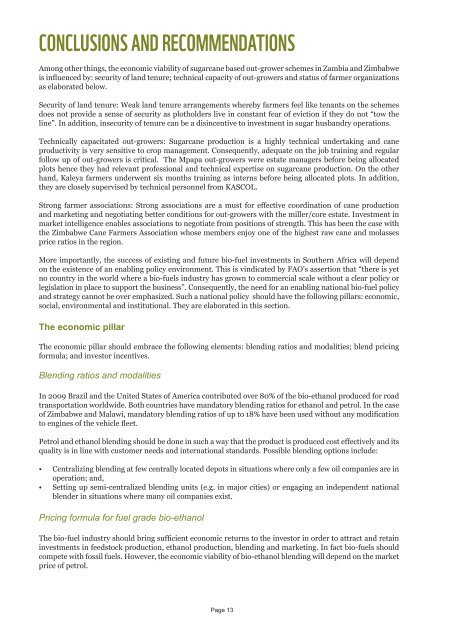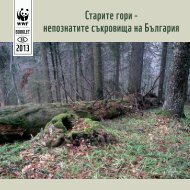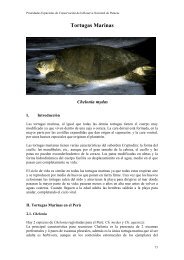Assessment of sugarcane outgrower schemes for
Assessment of sugarcane outgrower schemes for
Assessment of sugarcane outgrower schemes for
You also want an ePaper? Increase the reach of your titles
YUMPU automatically turns print PDFs into web optimized ePapers that Google loves.
CONCLUSIONS AND RECOMMENDATIONS<br />
Among other things, the economic viability <strong>of</strong> <strong>sugarcane</strong> based out-grower <strong>schemes</strong> in Zambia and Zimbabwe<br />
is influenced by: security <strong>of</strong> land tenure; technical capacity <strong>of</strong> out-growers and status <strong>of</strong> farmer organizations<br />
as elaborated below.<br />
Security <strong>of</strong> land tenure: Weak land tenure arrangements whereby farmers feel like tenants on the <strong>schemes</strong><br />
does not provide a sense <strong>of</strong> security as plotholders live in constant fear <strong>of</strong> eviction if they do not “tow the<br />
line”. In addition, insecurity <strong>of</strong> tenure can be a disincentive to investment in sugar husbandry operations.<br />
Technically capacitated out-growers: Sugarcane production is a highly technical undertaking and cane<br />
productivity is very sensitive to crop management. Consequently, adequate on the job training and regular<br />
follow up <strong>of</strong> out-growers is critical. The Mpapa out-growers were estate managers be<strong>for</strong>e being allocated<br />
plots hence they had relevant pr<strong>of</strong>essional and technical expertise on <strong>sugarcane</strong> production. On the other<br />
hand, Kaleya farmers underwent six months training as interns be<strong>for</strong>e being allocated plots. In addition,<br />
they are closely supervised by technical personnel from KASCOL.<br />
Strong farmer associations: Strong associations are a must <strong>for</strong> effective coordination <strong>of</strong> cane production<br />
and marketing and negotiating better conditions <strong>for</strong> out-growers with the miller/core estate. Investment in<br />
market intelligence enables associations to negotiate from positions <strong>of</strong> strength. This has been the case with<br />
the Zimbabwe Cane Farmers Association whose members enjoy one <strong>of</strong> the highest raw cane and molasses<br />
price ratios in the region.<br />
More importantly, the success <strong>of</strong> existing and future bio-fuel investments in Southern Africa will depend<br />
on the existence <strong>of</strong> an enabling policy environment. This is vindicated by FAO’s assertion that “there is yet<br />
no country in the world where a bio-fuels industry has grown to commercial scale without a clear policy or<br />
legislation in place to support the business”. Consequently, the need <strong>for</strong> an enabling national bio-fuel policy<br />
and strategy cannot be over emphasized. Such a national policy should have the following pillars: economic,<br />
social, environmental and institutional. They are elaborated in this section.<br />
The economic pillar<br />
The economic pillar should embrace the following elements: blending ratios and modalities; blend pricing<br />
<strong>for</strong>mula; and investor incentives.<br />
Blending ratios and modalities<br />
In 2009 Brazil and the United States <strong>of</strong> America contributed over 80% <strong>of</strong> the bio-ethanol produced <strong>for</strong> road<br />
transportation worldwide. Both countries have mandatory blending ratios <strong>for</strong> ethanol and petrol. In the case<br />
<strong>of</strong> Zimbabwe and Malawi, mandatory blending ratios <strong>of</strong> up to 18% have been used without any modification<br />
to engines <strong>of</strong> the vehicle fleet.<br />
Petrol and ethanol blending should be done in such a way that the product is produced cost effectively and its<br />
quality is in line with customer needs and international standards. Possible blending options include:<br />
• Centralizing blending at few centrally located depots in situations where only a few oil companies are in<br />
operation; and,<br />
• Setting up semi-centralized blending units (e.g. in major cities) or engaging an independent national<br />
blender in situations where many oil companies exist.<br />
Pricing <strong>for</strong>mula <strong>for</strong> fuel grade bio-ethanol<br />
The bio-fuel industry should bring sufficient economic returns to the investor in order to attract and retain<br />
investments in feedstock production, ethanol production, blending and marketing. In fact bio-fuels should<br />
compete with fossil fuels. However, the economic viability <strong>of</strong> bio-ethanol blending will depend on the market<br />
price <strong>of</strong> petrol.<br />
Page 13















